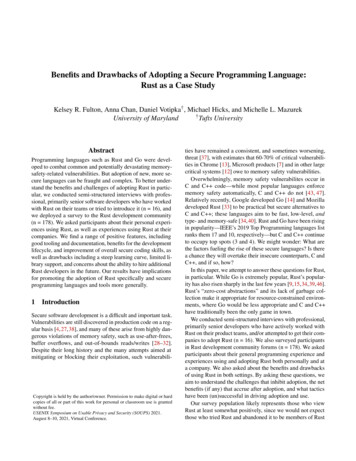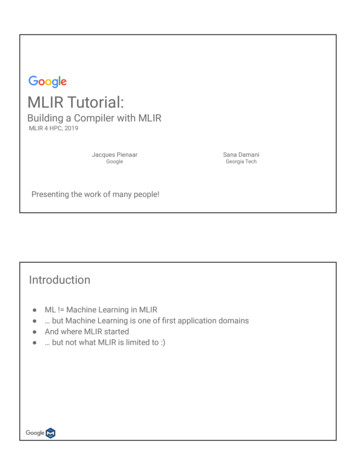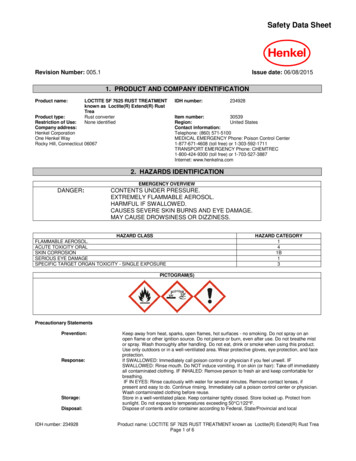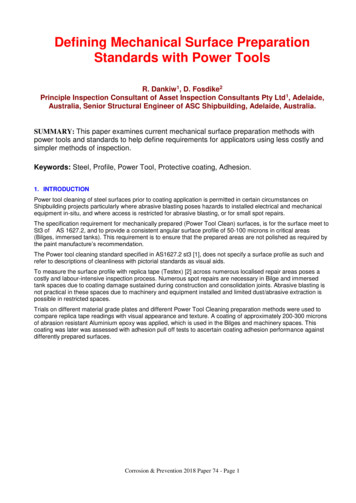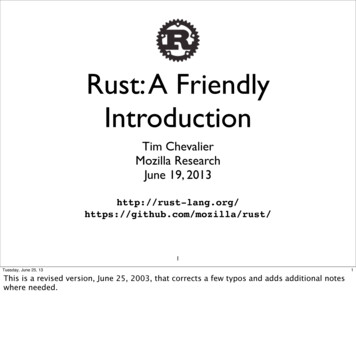
Transcription
Rust: A FriendlyIntroductionTim ChevalierMozilla ResearchJune 19, a/rust/1Tuesday, June 25, 13This is a revised version, June 25, 2003, that corrects a few typos and adds additional noteswhere needed.1
A language designprelude We designed Rust to bridge the performance gapbetween safe and unsafe languages. Design choices that seem complicated orsurprising on first glance are mostly choices thatfell out of that requirement. Rust’s compiler and all language tools are opensource (MIT/Apache dual license).2CC-BY-NC-SA image, Pamela RentzTuesday, June 25, 13this is mostly a talk about how to write code, but I couldn’t resist putting in some language design content,because to explain Rust it’s important to understand the problems we faced designing for a domain whereperformance concerns mean you can’t just do things like boxing/gc’ing everything2
Systems Programming Efficient code operating in resourceconstrained environments with direct controlover hardware C and C are dominant; systemsprogrammers care about very smallperformance margins For most applications we don’t care aboutthe last 10-15% of performance, but forsystems we do3CC-BY-NC-SA image, Tom RyanTuesday, June 25, 13ask for show of hands, how many people are C hackers, how many primarily in Java-ish languages“what is systems programming?” (point 1)“there’s a good reason why C is dominant”;I argue that the look & feel of the language necessarily follow from designing so as to bring safety to systemsprogramming3
Well, what’s wrong withC, then?dangling pointersbuffer overflowsarray bounds errors format string errorsnull pointer dereferencesdouble freesmemoryleaks “But I couldn't resist the temptation to put in a null reference, simplybecause it was so easy to implement. This has led to innumerableerrors, vulnerabilities, and system crashes, which have probablycaused a billion dollars of pain and damage in the last forty years.” Tony Hoare4Tuesday, June 25, 134
“Well-typed programsdon’t go wrong”Milner, “A theory of typepolymorphism in programming”,1978 Whatpointerswould it mean to gowrong?danglingbuffer overflowsarray boundserrorsRust’s typesystemis designedto beformatstring le freesmemoryWe can predict program behaviorleaksindependently of languageimplementation (This gives you more confidence that Rust programs will be reliable, not absoluteconfidence. Compilers and runtime systems may have bugs. Unsafe code voids the warranty. Offer not valid inNebraska.)5Tuesday, June 25, 135
Rust: like C, but. One reason why C persists is that there’s asimple relationship between the meaning ofyour code and the behavior of theunderlying machine This correspondence makes it relativelyeasy to write efficient code in C We want Rust to preserve this relationship6CC-BY-NC-SA image, Flickr user CyberslayerTuesday, June 25, 13Manual code review look at source code/assembly code (machine code?) side-by-side. Hardto imagine doing that in Java/Haskell/ML.Rust keeps the same model as C, matching C idioms where they matter (esp. WRTmemory allocation)6
with memory safety So what is memory safety?One definition: programsdereference only previouslyallocated pointers that have notbeen freed7Tuesday, June 25, 13CC-BY-NC-SA image, Flickr user sldownard7
.without runtime cost In safe languages like Java, Python, and Haskell,abstractions come with a runtime cost: boxing everythinggarbage-collecting everythingdynamic dispatchRust is about zero-cost abstractionsthere’s a cognitive cost: in Rust we have to thinkmore about data representation and memoryallocation. But the compiler checks ourassumptions.CC-BY-NC-SA image, Flickr user Randy Adams8Tuesday, June 25, 13say “soundness” but not in slide”“to add: resource constraints, low overhead, zero-cost abstractions (cite ROC)”(n.b. In some languages, e.g. ML, you can lose “boxing everything” if you also give upseparate compilation.)8
Roadmap:writing fast and safe code inRust Fun With TypesThe one thing I hope you Types Can Have Traitsremember: Pointers and Memory THE COMPILER CAN CHECKTHAT YOUR CODE USES SYSTEMS Bigger ExamplesPROGRAMMING PATTERNS SAFELY Testing, benchmarking. Questions?9Tuesday, June 25, 13I hope you’ll leave this talk wanting to learn more about Rust on your own. My goal is tobreak down the intimidation factor, not so much to teach you Rust in an an hour and a half.Hopefully the talk will give you a sense of why you would want to.note to self: try NOT to assume C knowledge as a baseline9
Disclaimer Some code examples have been simplifiedin trivial ways for clarity, and won’tnecessarily typecheck or compile When I post slides online I’ll documentchanges I’ve made for presentationpurposes10Tuesday, June 25, 13Changes needed to get code to compile will be in pink bold text in the notes10
Mutability Local variables in Rust are immutable bydefaultletlety x x 5;mut y 6;x;// OKx 1;// Type error11Tuesday, June 25, 13mutability-by-accident is a huge source of bugs11
Statements andexpressions Two kinds of statements in Rust: let var expr; expr; Everything is an expression; everything has a value Things that only have side effects have the typeEquivalent to letignore expr;() (“unit”)12Tuesday, June 25, 13no whitespace-sensitivity12
Functionsfn f(x: int) - int {x * x}No semicolonfn f(x: int) - int {return(x * x);}13Tuesday, June 25, 1313
Pointersstacklet x: int f();let y: @int @x;assert!(*y 5);/* Doesn’t typecheck */// assert!(y 5);heap5514Tuesday, June 25, 13- Rust has type inference, so you can usually leave off the types. I’m leaving them forpedagogical purposes.- Rust @-pointers can’t be nullFor most of the talk to make sense, you have to understand the difference between pointerand pointed-to14
Pointers and mutabilitylet mut x: int 5;increment(&mut x);assert!(x 6);// .fn increment(r: &mut int) {*r *r 1;}15Tuesday, June 25, 1315
EnumerationsRustCenum Color{Red,Green,Blue}typedef enum {Red,Green,Blue} color;16Tuesday, June 25, 13Relate to “fast and trustworthy”. Enum types let us write code that we know is exhaustive.In C: fast because enums are a compile-time thing, they just turn into small integers atruntimeC has two major problems here:1. Missing cases2. Being able to access fields of variants without checking tags16
Matching on enumerationsRustCfn f(c: Color) {match c {Red // .Green // .Blue // .}}void f(color c) {switch (c) {case Red: { /* . */break;}case Green: { /* . */break;}case Blue: { /* . */break;}}}(omitted return type means () )17Tuesday, June 25, 13show that C lets you add nonsense cases & (more importantly) leave out casesmention: in Rust, no fall-through; must include a default case ( ())point out again that match is an expression17
Nonsense casesRustCfn f(c: Color) {match c {Red // .Green // .Type17 error // .}}void f(color c) {switch (c) {case Red: { /* . */break;}case Green: { /* . */break;}case Blue: { /* . */break;}case 17: { /* . */break;}}}1814Tuesday, June 25, 13C accepts this because enums are “just” intsBut it probably indicates a programmer error18
Non-exhaustive matchesRustCfn f(c: Color) {match c {Red // .Green // .Exhaustiveness error}}void f(color c) {switch (c) {case Red: { /* . */break;}case Green: { /* . */break;}}}191415Tuesday, June 25, 1319the C version is perfectly OK!* what Rust gives you: checking that you have one case per variant, no missing cases and nononsense cases.This is hugely important in a large code base when you change a data structure. Knowing thecompiler will flag these errors gives you great peace of mind.Type system tells you that c is one of three possible values, instead of any int-sized value.Constraining the set of things a given variable could be is very useful, and gives you theability to know you’re handling all cases.
Enums can have fieldstypedef struct IntOption {bool is some;union {int val;void nothing;}}enum IntOption {None,Some(int)}RustC20Tuesday, June 25, 13Option safe replacement for possibly-null pointersShowing a specific version here, mention that in general this works on any typethis is nothing new -- Haskell/ML/etc. have had it for decades -- what’s newish (but not unique) is having it in a systems languageexample on R is a bit contrived since it’s just making C null pointers explicit. Bear with me!20
Checking for NullCIntOption opt random value();if (opt.is some) {printf(“%d\n”, opt.val);}21Tuesday, June 25, 13What if you left off the “if”? (Would dereference a null pointer.)Rust has a way to protect you from making that mistake.21
Destructuring in Rustlet opt: IntOption random value();Only wayto accessthe i field!match opt {None (), // do nothingSome(i) io::println(fmt!(“It’s %d!”, i))}22Tuesday, June 25, 1322There’s literally no way to construct code that extracts out the int field without checking thetagand again, Rust compiler checks that we covered every case and don’t have overlapping casessumming up: enums create data, pattern matching deconstructs them, and pattern matchesget checked to make sure we’re using data in a way that’s consistent with the invariantsimposed by its type
Pattern-matching andvectorsBinds tail to [2, 3] inthis caselet x [1, 2, 3];match x {[1, .tail] // .[ , .tail] // .[] // .}23Tuesday, June 25, 13one slide to both introduce vectors, and talk about slices?vectors: constant-time-random-access, dynamically sized sequences of elements of thesame type23
Structs Similar to C structs fields are laid out contiguously in memory, in the orderthey’re declared In C, allocating memory for a struct and initializing thefields are separate Rust guarantees that struct fields that can be named areinitialized24Tuesday, June 25, 13emphasize: no uninitialized fieldsBuzzwords: records; nominal types24
Struct examplestruct Element {parent: Node,tag name: str,attrs: [Attr],}// .let e: Element mk paragraph();assert!(e.tag name “p”);from Servo src/servo/dom/element.rs25Tuesday, June 25, 13Change str to str and [Attr] to [Attr]. Change “p” to ”p”25
Closuresfn apply(i: int, f: fn(int) - int) - int {f(i)}// .assert!(apply(4, x { x * x }) 16);“A function of one argument xthat returns the square of x”26Tuesday, June 25, 13Change fn(int) to &fn(int)(lambdas/anonymous/higher order functions) This is a feature that enables better codereuse.Also flexible control structures. Rust implements it efficiently.kind of a boring use of closures, yes. Next slide shows a more interesting one.26
Loopsfor range(0, 10) i {println(fmt!(“%u is an integer!”, i));}A standard library function that applies a closureto every number between (in this case) 0 and 1027Tuesday, June 25, 1327Add the line: use std::uint::range; at the top of the fileRust’s more-flexible loop constructs encourage more modular code, fewer tedious loopcounting errorsAt the same time, all of this is implemented in the language itself, as libraries. You can writeyour own looping constructs. The generated code is just as fast as C code that uses for loops.
(compiler steps)Loopsfor range(0, 10) i {println(fmt!(“%u is an integer!”, i));}expandrange(0, 10, i {println(fmt!(“%u is an integer!”, i));})inlinelet mut j 0;while j 10 {println(fmt!(“%u is an integer!”, j));j 1;}2825Tuesday, June 25, 13this is interesting because the code is really very different. top is a (sugared) call to ahigher-order function,bottom is a direct loopand there’s no magic involved -- just syntactic sugar and simple inlining28
Methodsstruct Pair { first: int, second: int }impl Pair {fn product(self) - int {self.first * self.second}}fn doubled product(p: Pair) - int {2 * p.product()}Method call29Tuesday, June 25, 1329
Generics Functions can be abstracted over types, notjust over values Data types can also have type parameters Generics vs. polymorphism: same concept,different terms (I’ll use “generics”)30Tuesday, June 25, 1330
Generic types: exampleenum Option T {Some(T),None}31Tuesday, June 25, 13Yes, it is meant to look like templates31
Generic functions:examplefn safe get T (opt: Option T , default: T) - T {match opt {Some(contents) contents,None default}}32Tuesday, June 25, 1332“like Java generics” -- types get specified at *compile* time, type parameters have no runtimemeaningdifference between this and templates: it’s possible to typecheck each function separately(which means better error messages),regardless of how it’s used. the step of expanding stuff out is separate. separate compilationin cmr’s words: “Cross-library generics without header files!”
Generic functions:implementation Compilergenerates:You write:fn safe get int(opt:Option int, default: int) - intlet x safe get(Some(16), 2);let y safe get(Some(true), false);let z safe get(Some(‘c’), ‘a’);fn safe get bool(opt:Option bool, default: bool) - boolfn safe get char(opt:Option char, default: char) - charenum Option int {Some int(int),None int}// same for bool and char33Tuesday, June 25, 1333bold orange stuff is all compiler-generatedcompare to C templates or Java genericscompiler “expands a template”/”makes a copy” with type variables set to specific types[anticipate question “how is this better than C templates?” -- one answer is traits (limitingwhat types something can expand to)]Separate typechecking/compilation
Interfacesfn all equal to T (ys: [T], x: T) - bool {for ys.each y {if y ! x {return false;}}true}Doesn’ttypecheck!34Tuesday, June 25, 13The problem is that there’s no general way to compare two values of an arbitrary type T forequalityWe need a way to be able to say “does T implement the Eq interface?”, and to be able toassume -- in a generic function T -- that the function only makes sense on types T thatsupport the Eq interface34
Types can have traitsRustC traitinterfaceimplimplementation35Tuesday, June 25, 1335
Trait exampletrait Mem {fn loadb(&mut self, addr: u16) - u8;fn storeb(&mut self, addr: u16, val: u8);}sprocketnes/mem.rs36Tuesday, June 25, 1336A trait defines an interface (collection of type signatures).[Recall that] Trait functions are called methods. Methods differ from functions because theyhave a self parameter that’s special.You can think of self -- here -- as having type &mut T: Mem.This trait defines the interface for types that represent a collection of memory.In this case, to count as a Mem, a type has to support two operations -- load and store, eachof which take or return a byte(this is a 16-bit machine). In sprocket, several different types implement Mem: PPU, RAM,VRAM, .
Trait boundsT is boundedfn store two bytes T: Mem (addr1:addr2:byte1:byte2:a mem:a mem.storeb(addr1, byte1);a mem.storeb(addr2, byte2);}u16,u16,u8,u8,&mut T) {37Tuesday, June 25, 13made-up example37
Implementationexample//// The NES' paltry 2KB of RAM//struct Ram { ram: [u8, .0x800] }impl Mem for Ram {fn loadb(&mut self, addr: u16) - u8{ self.ram[addr & 0x7ff] }fn storeb(&mut self, addr: u16, val: u8){ self.ram[addr & 0x7ff] val }}sprocketnes/mem.rs38Tuesday, June 25, 13the impl item is a concrete implementation of the trait Mem for the type Ramthe concrete type Ram here is a fixed-length vector of bytes, but in theory it could be anytype on which you can implement these operations38
Static vs. dynamicdispatch The compiler compiles all the code we’ve beentalking about (so far) with static dispatch: thefunction being called is known at compile time Static dispatch is more efficient, because callinstructions always go to a known address You can trade performance for flexibility and usedynamic dispatch n.b. In languages like Java, Python, Ruby (.) dynamicdispatch is all there is. In Rust you have a choice.39Tuesday, June 25, 1339
Dynamic dispatcha list of objects that may havedifferent types, so long as alltypes are Drawabletrait Drawable { fn draw(&self); }fn draw all(shapes: [@Drawable]) {for shapes.each shape { shape.draw(); }}from the Rust html40Tuesday, June 25, 13Change [@Drawable] to [@Drawable]* another for loop.* we need the @ sigil to show where a Drawable object is stored, and to make it clear it’s apointer* by itself, Drawable is not a type. But @Drawable / Drawable / T are types40
Static vs. dynamicfn draw T: Drawable (shapes: &[T]) {for shapes.each shape {shape.draw();}}fn draw(shapes: &[@Drawable]) {for shapes.each shape {shape.draw();}}compilerfn draw circles(shapes: &[Circle]) { .fn draw rectangles(shapes: &[Rectangle]){ .fn draw(shapes: .) {for shapes.each shape {let vtable shape.vtable;call vtable.draw(shape);}}(pseudocode)41Tuesday, June 25, 13On the right, the generated code is doing work *at runtime* to look up the draw method foreach object.On the left, the compiler generates a copy at *compile time* of the draw function for eachshape type that draw gets used with.as with templates, “the compiler generates a copy of every parameterized fn and ty”)41
Traits: summing up Traits provide us with code reuse for noruntime cost, when using static dispatch Can use dynamic dispatch for greaterflexibility, when you’re willing to pay the cost In Rust, you can use either style depending oncontext; the language doesn’t impose apreference on you (Traits are inspired by Haskell type classes, but don’t worry if you don’tknow about those)42Tuesday, June 25, 13Unifying static/dynamic dispatch is a new thingemphasize code reuse safety, because less duplication less bugs42
Changing gears(questions so far?)43Tuesday, June 25, 13CC-BY-NC-SA image, Flickr user Tom Magliery43
Memory in Rust Existing languages tend to either not supportexplicit pointers (e.g. Java, Haskell) orsupport them without detecting obviouserrors (e.g. C/C ). There’s another way! Rust’s performance goals don’t admitgarbage-collecting everything as a solution At the same time, want to avoid the hazardsof manual memory management44CC-BY-NC-SA image, Flickr user Dennis van ZuijlekomTuesday, June 25, 13memory in Rust; using pointers safely.Brian said “pointerless vs. pointerful” comparison is goodpoint 2 fast, point 3 safe44
Pointers and memory45Tuesday, June 25, 13Crucial point is that “pointerless” languages (Java, Haskell, ML, dynamic langs.) have to box everything; they lack the ability to talk about non-pointer-sized things in the language(1, 2) in Haskell always [*] means a pointer to a heap-allocated record with two data fields(the compiler can optimize this sometimes, but the language gives no guarantees)makes it simpler to compile polymorphism, b/c the compiler knows the size of everything. But that’s not the only way!** can’t rely on this optimization if *predictable* (consistent) performance is important45
Boxed vs. unboxedfn f(p: @(int, int)) { }fn f(p: (int, int)) { }StackHeap46Tuesday, June 25, 1346in some languages, you wouldn’t be able to express this distinction -- compound data wouldalways live on the heap.In Rust, you can choose whether it lives on the stack or in the heap.Difference is that stack-allocated data has a natural lifetime corresponding to lexical scope-- no need for GC/etc.(Same caveat as in slide 8: (n.b. In some languages, e.g. ML, you can lose “boxing everything”if you also give up separate compilation.))
“Rust has three kindsof pointers?” Actually, Rust has four kinds of pointersBut the secret is, C does too In C , *T can mean many different things; theparticular meaning in a given context lives in theprogrammer’s head In Rust, the pattern is explicit in the syntax;therefore checkable by the compiler47Tuesday, June 25, 13 The difference is, Rust helps you remember which kind you’re using at any given moment47
Different Patterns Managed pointer to T Owned pointer to T Borrowed pointer to T Unsafe pointer to TRustC @T*T T*T&T*T*T*TThe Rust compiler checks that code useseach pointer type consistently with itsmeaning.48Tuesday, June 25, 13Graydon points out “also, compiler can prove it’s safe”and yes, C has references/smart pointers/etc., but the treatment of these in Rust isbetter-integrated,more uniform, more easily checkable.the C compiler *can’t* check it since it doesn’t know what type you meant!48
Managed Pointersfn remember(s: &mut Set, foo: @(int, int)) {LocalHeap// . add to set .} foo is a pointer into the local heap The local heap is called “managed” because. the caller need not manually free pointers into it; the compiler/runtimefrees it when it’s no longer needed, either using garbage collection or bygenerating automatic reference-counting code49Tuesday, June 25, 13 (which one it uses is an implementation detail)49
Owned pointers Conceptually, there are actually several heaps:No GCGlobal HeapLocalHeap LocalHeapLocalHeapLocalHeapGCAn allocation in the global heap has a single owner(a block scope or parent data structure that’sresponsible for freeing that allocation).50Tuesday, June 25, 13Different tasks, different heapsCould mention as an aside that the managed heap is also per-task and the exchange heapcan be used to move data between taskspointers can point from one heap to the other50
Preventing copiesThis says “pass the.}argumentby value”fn h(b: [int]) {fn g(a: [int]) { . }fn f(n: uint) {let v: [int] vec::from elem(n, 2);h(v);Typecheckerg(v);}rejects this call51Tuesday, June 25, 13Before I talk about the last kind of pointer (borrowed) I want to talk about move semanticsthe location of v gets zeroed out when we call h. So the call to g wouldn’t be sound -- gwouldget a dangling pointer. Rust’s typechecker prevents that. In addition, we don’t interpret thecall as a copybecause v is a big value. Calling h “transfers ownership” of v to h51
Borrowed pointersfn f(a big number: uint) - uint {let mut big vector [];for range(0, a big number) n {big vector [n];}sum(big vector)}fn sum(v: &[int]) - int { . }The type tells us that sum“borrows” v -- it can’t return it as a result52Tuesday, June 25, 1352I explained that we can’t just go wantonly copying big data structures. There has to be asingle pointerto them.Borrowed pointers let us have multiple pointers to the same data structure, as long as it’sobvious who theowner is -- the owner is responsible for freeing it/cleaning it up.this is a bit misleading since &[]. is not just “a reference to a vector”.No refcounting/etc. needed for managing v -- it gets deallocated automatically on exit from fTypechecker checks that v is valid for the whole time sum uses it
A bad examplestruct Cat { }struct WebCam {target: &Cat}Field that’s areference to a Catfn make a cat() {let cat Cat::new();let webcam WebCam::new(&cat);send cat to moon(cat);take photograph(&webcam);}The typechecker will rejectthis codeThe pointer to cat insidewebcam is now danglingfn take photograph(webcam: &WebCam) {webcam.target.focus();webcam.snap();}53Tuesday, June 25, 1353This slide omits the definition for the static methods Cat::new and WebCam::new (since Ididn’t mention static methods in the talk). Also, I omitted field definitions for the Catstruct. Finally, the reference to Cat inside WebCam actually needs lifetime variables,which I didn’t talk about.assume Cat is not copyable.This would crash in C . Rust catches it at compile time. A different solution is to use GC(which would mean cat gets kept alive) but we don’t want to force everything to use it. So inRust,code like this runs full speed. No GC overhead.
Borrowed pointers(summary) It’s perfectly safe to borrow a pointer to data in a stackframe that will outlive your own It’s also efficient: the compiler proves statically that lifetimesnest properly, so borrowed pointers need no automaticmemory management Rust accomplishes both of these goals without making theprogrammer responsible for reasoning about pointerlifetimes (the compiler checks your assumptions)54Tuesday, June 25, 1354
Why bother? Rust makes you think a lot about borrowed pointers andownership. What do you get in return? The ability to write common patterns (interior pointers thatcan be returned from functions, lexically nested chains ofborrows) and know that no dangling pointers or memoryleaks will occur at runtime You would also have to do the same reasoning if you werewriting systems code in C . Rust gives you to the tools tomake that reasoning explicit and to help the compiler help youcheck it. Rust’s type system also helps avoid expensive copy operationsthat you didn’t intend to do55Tuesday, June 25, 13PROBABLY SKIP NEXT BIT55
Traits and pointers: anextended exampleprivacyannotationdoc commentpub trait Container {/// Return the number of elements in thecontainerfn len(&self) - uint;/// Return true if the container contains noelementsfn is empty(&const self) - bool;}“A container, by definition, supports the len andis empty operations”56Tuesday, June 25, 13I didn’t use these remaining slides in the talk. They probably won’t compile.Read at your own risk!56
Trait inheritancethis method must be called on amutable reference to a T that hasthe Mutable traitpub trait Mutable: Container {/// Clear the container, removing all values.fn clear(&mut self);}“A mutable container, by definition, is acontainer that supports the additional clearoperation”57Tuesday, June 25, 1357
Concrete type:HashMappub struct HashMap K,V {priv k0: u64,priv k1: u64,priv resize at: uint,priv size: uint,priv buckets: [Option Bucket K, V ],}struct Bucket K,V {hash: uint,key: K,value: V}}(details aren’t too important, I just wanted toshow you the type that we’re implementingContainer on)58Tuesday, June 25, 1358
Traits and pointers: anextended example“K is any type that has the Hashand Eq traits”impl K:Hash Eq,V Container for HashMap K, V {/// Return the number of elements in the mapfn len(&const self) - uint {self.size}/// Return true if the map contains no elementsfn is empty(&const self) - bool {self.len() 0}}59Tuesday, June 25, 13pretty straightforward, just note the Hash Eq syntax for multiple boundsHashMap also has to implement Mutable, and then there’s the whole Map trait, but no roomfor that.59
The Map trait: more withborrowed pointerspub trait Map K, V : Mutable {/// Return true if the map contains a value for the specified keyfn contains key(&self, key: &K) - bool;Change this to each/// Visit all keysfn each key(&self, f: &fn(&K) - bool) - bool;/// Return a reference to the value corresponding to the keyfn find 'a (&'a self, key: &K) - Option &'a V ;/// Insert a key-value pair into the map. An existing value for a/// key is replaced by the new value. Return true if the key did/// not already exist in the map.fn insert(&mut self, key: K, value: V) - bool;/// Removes a key from the map, returning the value at the key if the key/// was previously in the map.fn pop(&mut self, k: &K) - Option V ;}60Tuesday, June 25, 13removed some methods for clarityNotice that if you implement this trait, you *can* implement a hash map with C-style,no-overhead pointers (you *could* use automatic GC in the implementation but it doesn’tforce you to)Graydon says font is too small60
Borrowed pointers: anextended exampleimpl K:Hash Eq,V Mutable for HashMap K, V {/// Clear the map, removing all key-value pairs.fn clear(&mut self) {for uint::range(0, self.buckets.len()) idx {self.buckets[idx] None;}self.size 0;}}61Tuesday, June 25, 13Talk about for loops and closures more (and how they compile into actual loops)61
Borrowed pointers: anextended exampleimpl K:Hash Eq,V Map K, V for HashMap K, V {/// Return true if the map contains a value forthe specified keyfn contains key(&self, k: &K) - bool {match self.bucket for key(k) {FoundEntry( ) true,TableFull FoundHole( ) false}}}62Tuesday, June 25, 13Talk about or-patterns. Otherwise, does this really need to be here?62
Borrowed pointersexampleimpl K:Hash Eq,V Map K, V for HashMap K, V {/// Visit all key-value pairsfn each 'a (&'a self,blk: &fn(&K, &'a V) - bool) - bool {for self.buckets.each bucket {for bucket.each pair {if !blk(&pair.key, &pair.value) {return false;}}}return true;}}63Tuesday, June 25, 13talk about for-loop protocol moretalk about early-return and return-out-of-closuresGraydon says avoid explaining the for loop protocol63
Borrowed pointersexampleimpl K:Hash Eq,V Map K, V for HashMap K, V {/// Return a reference to the value correspondingto the keyfn find 'a (&'a self, k: &K) - Option &'a V {match self.bucket for key(k) {FoundEntry(idx) Some(self.value for bucket(idx)),TableFull FoundHole( ) None,}}}64Tuesday, June 25, 13This is not too different from contains key64
Borrowed pointerexampleimpl K:Hash Eq,V Map K, V for HashMap K, V {/// Removes a key from the map, returning the value at the key ifthe key/// was previously in the map.fn pop(&mut self, k: &K) - Option V {let hash k.hash keyed(self.k0, self.k1) as uint;self.pop internal(hash, k)}}65Tuesday, June 25, 13the interesting part is that we return the value by-move. but how to get this across withoutgoing into too many tedious details about pop internal?65
Miscellaneous Fun Stuff Lightweight unit testing (heavily used in Rustlibraries):#[test]fn test find() {let mut m HashMap::new();assert!(m.find(&1).is none());m.insert(1, 2);match m.find(&1) {None fail!(),Some(v) assert!(*v 2)}} rustc map.rs --test -o maptest generates an executable maptest plus code that runstests and prints out neatly-formatted results66Tuesday, June 25, 13This is skippable66
Benchmarking#[bench]fn bench uint small(b: &mut BenchHarness) {let mut r rng();let mut bitv 0 as uint;do b.iter {bitv (1 ((r.next() as uint) % uint::bits));}}
stack heap Tuesday, June 25, 13 14 - Rust has type inference, so you can usually leave o! the types. I’m leaving them for pedagogical purposes. - Rust @-pointers can’t be null For most of the talk to make sense, you have t


